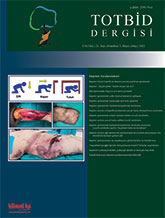
Compartment syndrome is a clinical condition in which tissue perfusion is impaired and requires urgent treatment because of the possibility of permanent damage. If it is not diagnosed and treated early, permanent loss of function for the patient causes serious medicolegal problems for the treating physician. It is most commonly seen after fractures, direct blows, burns, and frostbite and reperfusion. It can also occur with simple traumas in those with bleeding disorders. In the lower extremity, the legs and in the upper extremities forearm are the most common areas of occurance. In relation to earthquakes, there are striking differences in the diagnosis and treatment of compartment syndrome compared to other mechanisms. When crushing time exceeds 8-10 hours, crush injury and compartment syndrome findings are mixed. While fasciotomy is the best treatment for acute compartment syndrome, fasciotomy should be avoided in late compartment syndrome and crush-related muscle injury. In cases where urgent decision is required, fasciotomies with limited incisions can be used as a risk-reducing option in cases where follow-up is not possible. However, re-evaluation of cases with limited fasciotomy is of great importance.